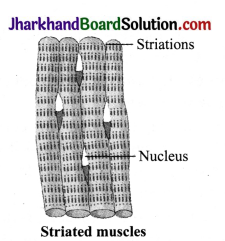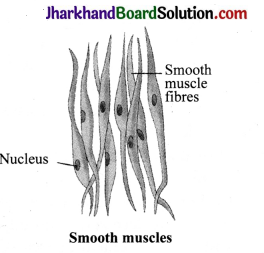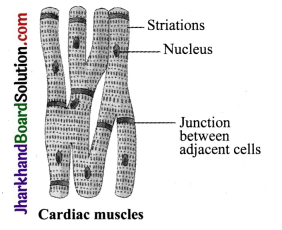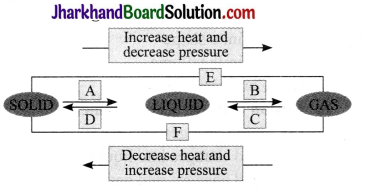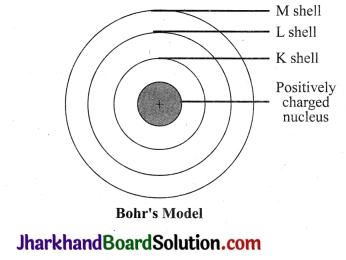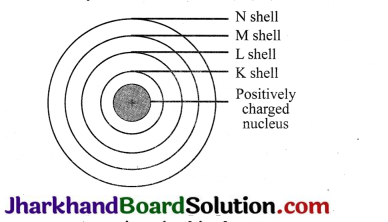JAC Board Class 9th Social Science Important Questions History Chapter 2 यूरोप में समाजवाद एवं रूसी क्रांति
वस्तुनिष्ठ प्रश्न
1. निरंकुश राजशाही के खिलाफ रूस में प्रथम क्रान्ति हुई
(अ) सन् 1905 ई. में
(ब) सन् 1978 ई. में
(स) सन् 1917 ई. में
(द) सन् 1919 ई. में।
उत्तर:
(अ) सन् 1905 ई. में।
2. रूस के स्थानीय स्वशासी संगठन कहलाते थे
(अ) सोवियत
(ब) पेत्रोग्राद
(स) ड्यूमा
(द) उपर्युक्त सभी।
उत्तर:
(अ) सोवियत।
3. रूसी क्रान्ति के समय रूस का शासक था
(अ) निकोलस प्रथम
(ब) निकोलस द्वितीय
(स) लेनिन
(द) कोई नहीं।
उत्तर:
(ब) निकोलस द्वितीय।
4. रूस में सामूहिक खेतों को कहा गया
(अ) घुमन्तू
(ब) कोलखोज
(स) विण्टर पैलेस
(द) कुलक।
उत्तर:
(ब) कोलखोज।
5. बोल्शेविक क्रान्ति के नाम से जाना जाता है
(अ) सं. राज्य अमेरिका की क्रान्ति को
(ब) जर्मनी की क्रान्ति को
(स) भारत की क्रान्ति को।
(द) रूस की क्रान्ति को।
उत्तर:
(द) रूस की क्रान्ति को।
6. रूस की संसद का नाम था
(अ) ड्यूमा
(ब) मजलिस
(स) पार्लियामेन्ट
(द) कोई नहीं।
उत्तर:
(अ) ड्यूमा।
अति लघूत्तरात्मक प्रश्न
प्रश्न 1.
रूसी कान्ति किस जार के शासनकाल में हुऱे?
उत्तर:
निकोलस द्वितीय के शासनकाल में।
![]()
प्रश्न 2.
प्रथम विश्वयुद्ध के समय रुस का शासक कौन था?
उत्तर:
जार निकोलस द्वितीय।
प्रश्न 3.
सन् 1905 ई. की रून की क्रान्ति का प्रमुख कारण क्या था?
उत्तर:
जार का निरंकुश शासन।
प्रश्न 4.
रूसी क्रान्ति की सबसे महत्वपूर्ण उपलब्धि क्या थी?
उत्तर:
चर्च की शक्ति एवं निरंकुश श्ञासन की समाप्ति।
प्रश्न 5.
रुसी क्रान्ति किसे कहते हैं?
उत्तर:
फरवरी, सन् 1917 ई, में राजशाही का पतन एवं अक्टूबर की घटनाओं को रूसी क्रान्ति कहते हैं।
प्रश्न 6.
रुस में बोल्शेखिक क्रान्ति कब्ब हुई?
उत्तर:
सन् 1917 ई. में।
प्रश्न 7.
रूसी क्रान्ति को विश्व इतिहास की महत्वपूर्ण घटना क्यों माना जाता है?
उत्तर:
समाजवाद की स्थापना के कारण रूसी क्रान्ति को विश्व इतिहास की महत्वपूर्ण घटना माना जाता है।
![]()
प्रश्न 8.
ऐसे दो भारतीय सुधारकों के नाम बताओ जिन्होंने रुस की क्रान्ति के महत्व के बारे में बताया।
उत्तर:
- पं. जवाहर लाल नेहरू,
- एस. डी. विद्यालंकार।
प्रश्न 9.
सन् 1898 ई. में रूस में समाजवादियों ने किस पार्टी की स्थापना की?
उत्तर:
रशियन सोशल डेमोक्रैटिक वर्कर्स पार्टीं की।
प्रश्न 10.
रूस की क्रान्ति में बोल्शेविक खेमे का नेतृत्व कौन कर रहा था?
उत्तर:
ब्लादिमीर लेनिन।
प्रश्न 11.
रुसी क्रान्ति से पूर्व रूस में कौन-कौन से दल थे?
उत्तर:
- बोल्शेविक,
- मेन्शेविक।
प्रश्न 12.
सर्वप्रथम रुसी क्रान्ति का झंडा कहाँ फहराया गया?
उत्तर:
पेत्रोग्राद में।
प्रश्न 13.
किस संन्यासी ने रूस में राजशाही को और अधिक अलोकप्रिय बना दिया।
उत्तर:
रासपुतिन ने।
![]()
प्रश्न 14.
कार्ल मार्क्स कौन था?
उत्तर:
कार्ल मार्क्स आधुनिक समाजवाद का जनक था। वह मूलतः जर्मनी का एक महान् विचारक था।
प्रश्न 15.
रूसी सेनाओं को कब एवं कहाँ पराजय झेलनी पड़ी?
उत्तर:
रुसी सेनाओं को सन् 1914 ई. से सन् 1916 ई. के मध्य जर्मनी और ऑस्ट्रिया में पराजय शेलनी पड़ी।
प्रश्न 16.
रूसी स्टीम रोलर किसे कहा जाता है?
उत्तर:
शाही रूसी सेना को रूसी स्टीम रोलर कहा जाता है।
प्रश्न 17.
सन् 1917 ई. की रूसी क्रान्ति किस विचारधारा से सबसे अधिक प्रभावित थी?
उत्तर:
सन् 1917 ई. की रुसी क्रान्ति समाजवादी विचारधारा से सबसे अधिक प्रभावित थी।
![]()
प्रश्न 18.
बोल्शेविक पार्टी का संस्थापक कौन था? इस पार्टी के मुख्य उद्देश्य क्या थे?
उत्तर:
बोल्शेविक पार्टीं का संस्थापक ब्लादिमीर लेनिन था। उसका मुख्य उद्देश्य जार निकोलस द्वितीय के शासन को उखाड़ फेंकना तथा रूस में कम्युनिस्ट सरकार की स्थापना करना था।
प्रश्न 19.
मित्र राष्ट्र किन शक्तियों को कहा जाता था?
उत्तर:
ब्रिटेन, फ्रांस एवं रुस आदि शक्तियों को मित्र राष्ट्र कहा जाता था?
प्रश्न 20.
संघों का महासंघ किसे कहा गया?
उत्तर:
वकीलों, इंजीनियरों, डॉक्टरों एवं मध्यमवर्गीय कामगारों ने मिलकर एक संगठन की स्थापना की जिसे संघों का महासंघ कहा गया।
प्रश्न 21.
निजी सम्पत्ति की व्यवस्था के खिलाफ कौन थे?
उत्तर:
बोल्शेविक।
प्रश्न 22.
बोल्शोविक पार्टी का बदला हुआ नाम क्या था?
उत्तर:
रूसी कम्युनिस्ट पार्टी (बोल्शेविक)।
प्रश्न 23.
बोल्शेविकों ने जर्मनी से कब एवं कहाँ संधि कर ली?
उत्तर:
बोल्शेविकों ने जर्मनी से ब्रेस्ट लिटोव्सक में मार्च सन् 1918 ई. में संधि कर ली।
प्रश्न 24.
क्रॉमिन्टर्न क्या हैं?
उत्तर:
बोल्शेविक समर्थक समाजवादी पार्टियों के अन्तर्राट्रीय महासंध को कांमिन्टर्न के नाम से जाना गया।
![]()
प्रश्न 25.
समाजवादी निजी सम्पत्ति के विरोधी क्यों थे?
उत्तर:
समाजवादी निजी सम्पत्ति को सभी बुराइयों की जड़ मानते थे।
प्रश्न 26.
भारत में स्वतन्त्रता के बाद लागू की गई पंचवर्षीय योजनाएँ किस देश से प्रभावित थीं?
उत्तर:
रूस से।
लघूत्तरात्मक प्रश्न
प्रश्न 1.
19वीं शताब्दी के यूरोप में सामाजिक-आर्थिक परिवर्तनों के प्रति अतिवादियों का क्या दृष्टिकोण था?
उत्तर:
19वीं शताब्दी के यूरोप में सामाजिक-आर्थिक परिवर्तनों के प्रति क्रान्तिकारी या अतिवादियों के दृष्टिकोण को निम्नलिखित रूप में व्यक्त किया जा सकता है
- उन्नीसवीं शताब्दी में अतिवादी या क्रान्तिकारी पार्टियाँ मत देने के अधिकार को अधिक विस्तृत कराना चाहती थीं। वे राजनीति में अधिक से अधिक लोगों की भागीदारी की पक्षधर थीं।
- अतिवादी बड़े जमींदारों, कारखाना मालिकों या व्यापारियों के हाथ में सम्पत्ति के केन्द्रीकरण के विरुद्ध थे।
प्रश्न 2.
रूस के इतिहास में कौन-सी घटना ‘खूनी रविवार’ के नाम से जानी जाती है?
उत्तर:
रूस में निरंकुश राजशाही थी। रूस के जार (सम्राट) के अधिकारी जन साधारण वर्ग पर भीषण अत्याचार करते थे। 9 जनवरी, सन् 1905 ई. को रविवार के दिन पादरी गैपॉन के नेतृत्व में मजदूरों का एक वर्ग अपनी मांगों के समर्थन में एक जुलूस निकालता हुआ जार के महल विंटर पैलेस के सामने पहुंचा तो पुलिस और कोसैक्स ने उन पर हमला बोल दिया। इस घटना में 100 से अधिक मजदूर मारे गये और लगभग 300 घायल हो गये। सन् 1905 ई. की क्रान्ति की शुरुआत इसी घटना से हुई। इतिहास में इस घटना को खूनी रविवार के नाम से जाना जाता है।
प्रश्न 3.
सन् 1917 ई. में पेत्रोग्राद में फरवरी क्रान्ति के क्या कारण थे?
उत्तर:
पेत्रोग्राद में फरवरी क्रान्ति के निम्नलिखित कारण थे
- फरवरी में मजदूरों के निवास क्षेत्रों में खाद्य पदार्थों की भारी कमी उत्पन्न हो गई।
- संसदीय प्रतिनिधि चाहते थे कि निर्वाचित सरकार बची रहे, इसलिए वह जार द्वारा ड्यूमा को भंग करने के लिए की जा रही कोशिशों का विरोध कर रहे थे।
- फरवरी सन् 1917 ई. में नेवा नदी के दाएँ तट पर स्थित एक फैक्ट्री में तालाबन्दी कर दी गई।
- रविवार 25 फरवरी को अपने निरंकुश शासन को बनाये रखने के लिए जार ने ड्यूमा को बर्खास्त कर दिया।
प्रश्न 4.
“रूसी जनता की समस्त समस्याओं का हल रूसी क्रान्ति में निहित था।”इस कथन को स्पष्ट कीजिए।
उत्तर:
सन् 1917 ई. की रूसी समाजवादी क्रान्ति विश्व के इतिहास में एक अभूतपूर्व घटना थी। जार निकोलस द्वितीय का निरंकुश शासन रूस के लिए एक अभिशाप बन चुका था। रूस के किसानों, मजदूरों एवं जनसाधारण की दशा अत्यन्त दयनीय थी। रूस कृषि एवं औद्योगिक दृष्टि से एक पिछड़ा हुआ देश था। केरेस्की के नेतृत्व में जो लोकतान्त्रिक व्यवस्था स्थापित की गई थी, वह भी पतन की ओर अग्रसर थी।
प्रथम विश्व युद्ध ने रूस की आन्तरिक दशा को अधिक दयनीय बना दिया। लाखों रूसी सैनिक मौत के मुँह में चले गये और अनेक घायल हो गए। रूसी क्रान्तिकारी इन स्थितियों से निपटने के लिए विश्वयुद्ध से अलग होना, गैर-रूसी जातियों को समान अधिकार देना, जमीन का मालिकाना हक किसानों को देना तथा उद्योगों पर मजदूरों का नियन्त्रण करना चाहते थे।
![]()
प्रश्न 5.
‘बोल्शेविक कौन थे? संक्षेप में बताइए।
उत्तर:
‘बोल्शेविक रूस के औद्योगिक मजदूरों की एक राजनीतिक पार्टी थी, जिसका नेता ब्लादिमीर लेनिन था। इस पार्टी के साथ औद्योगिक मजदूरों की बहुत अधिक संख्या थी। यह गुट क्रान्तिकारी विचारधारा में विश्वास रखता था। उनका विचार था कि जिस देश में न तो संसद हो और न ही नागरिकों को कोई जनतान्त्रिक अधिकार दिए गए हों, वहाँ शान्तिपूर्ण तरीके से कोई परिवर्तन नहीं लाए जा सकते। अन्त में यह पार्टी सन् 1917 ई. में रूस में एक क्रान्ति लाने में सफल हुई।
प्रश्न 6.
स्वस में श्रमिकों की पंचायत (सोवियतों का निर्माण कैसे हुआ?
उत्तर:
रविवार 25 फरवरी सन् 1917 को सरकार ने ड्यूमा को बर्खास्त कर दिया। इसके विरोध में जगह-जगह प्रदर्शन होने लगे तथा रोटी, वेतन, काम के घण्टों में कमी तथा लोकतान्त्रिक अधिकारों के पक्ष में बड़ी मात्रा में लोग सड़कों पर प्रदर्शन करने लगे। जब सरकार ने उन्हें काबू में करने के लिए सैनिकों को आदेश दिया तो उन्होंने अपने अफसर पर गोली चला दी और बगावत कर दी।
कई रेजीमेन्टों के सैनिक हड़ताली मजदूरों के साथ आ गये तथा जिस इमारत में यक की बैठक होती थी, उसी में एकत्र होकर एक सोवियत (परिषद) का गठन किया, जिसे पेत्रोपाद सोवियत कहा गया। इसके बाद अन्य स्थानों पर भी सोवियतों का गठन होने लगा।
प्रश्ना 7.
लेनिन की प्रमुख माँगें कौन-सी थी? उन्हें किस नाम से जाना जाता है?
उत्तर:
लेनिन की प्रमुख तीन मांगे निम्नलिखित थीं
- पुत्र को समाप्त किया जाए।
- समस्त जमीन किसानों को दे दी जाए।
- बैंकों का राष्ट्रीयकरण किया जाए। इन तीनों माँगों को लेनिन की ‘अप्रैल थीसिस’ के नाम से जाना जाता है।
प्रश्न 8.
स्तालिन द्वारा सामूहिकीकरण का निर्णय क्यों लिया गया ? कुलक तथा अन्य किसानों ने इसका विरोध क्यों किया?
उत्तर:
स्तालिन का यह मानना था कि कुलक और व्यापारी कीमत बढ़ने की उम्मीद में अनाज नहीं बेच रहे हैं और मिलकर जमाखोरी कर रहे हैं और इस कारण बाजार में कृत्रिम खाद्यान्न संकट उत्पन्न हो गया है। इसके अतिरिक्त छोटे कृषि फार्मों का मशीनीकरण भी सम्भव नहीं था।
बड़े फामों पर मशीनों के उपयोग से खेती को अधिक लाभकारी बनाया जा सकता था इसीलिए स्तालिन ने यह निर्णय लिया कि बड़े सामूहिक फार्म बनाए जाएंगे जिन पर किसान उसी प्रकार काम करेंगे जैसे कारखानों में मजदूर काम करते हैं। कुलकों एवं किसानों ने अपनी भूमि पर सरकारी नियन्त्रण का विरोध किया, क्योंकि वे पहले अपनी जमीन के मालिक थे। सामूहिकीकरण की प्रक्रिया द्वारा वे मात्र मजदूर बनकर रह जाते। स्तालिन ने किसानों और कुलकों के इस विरोध को सख्ती से कुचल दिया।
![]()
प्रश्न 9.
अक्टूबर सन् 1917 ई. की रूसी क्रान्ति की सफलता के लिए लेनिन द्वारा उठाए गए कदमों के बारे में संक्षेप में बताइए।
उत्तर:
अक्टूबर 1917 ई. की रूसी क्रान्ति की सफलता के लिए लेनिन ने निम्न कदम उठाये
- जार निकोलस द्वितीय के शासन के पतन के बाद लेनिन ने ही क्रान्तिकारियों का नेतृत्व किया।
- केरेस्की के नेतृत्व में अन्तरिम सरकार लोगों की मांगों को पूरा करने में असफल रही, जिससे लेनिन ने घोषणा की कि अन्तरिम सरकार के स्थान पर अब सोवियतों को शासन दिया जाना चाहिए।
- लेनिन के नेतृत्व में बोल्शेविक पार्टी ने युद्ध समाप्त करने, किसानों को जमीन देने तथा समस्त अधिकार सोवियतों को देने सम्बन्धी स्पष्ट नीतियाँ सामने रखीं।
- लेनिन ने सभी रूसी साम्राज्यों को राष्ट्रों का कारागार कहा था और घोषणा की थी कि सभी गैर-रूसी लोगों को समान अधिकार दिए बिना वास्तविक लोकतन्त्र की स्थापना नहीं हो सकती।
प्रश्न 10.
सन् 1917 ई. की रूसी क्रान्ति के बाद लेनिन द्वारा किए गए प्रमुख कार्यों का वर्णन कीजिए।
उत्तर:
अक्टूबर सन् 1917 ई. की क्रान्ति के बाद लेनिन द्वारा किए गए प्रमुख कार्य निम्नलिखित थे
- सरकार द्वारा निजी सम्पत्ति के अधिकार को समाप्त कर दिया गया।
- उद्योगों का नियन्त्रण मजदूर सोवियतों एवं श्रमिक संघों को दे दिया गया।
- उत्पादन के सभी साधनों पर सरकार का नियन्त्रण स्थापित हो गया।
- बैंकों, बड़े उद्योगों, खानों तथा बड़ी कम्पनियों का राष्ट्रीयकरण कर दिया गया।
प्रश्न 11.
लेनिन ने रूस की कृषि एवं अर्थव्यवस्था में सुधार के लिए कौन-कौन से कदम उठाए? उनका संक्षिप्त वर्णन कीजिए।
उत्तर:
लेनिन ने रूस की कृषि एवं अर्थव्यवस्था में सुधार के लिए निम्नलिखित कदम उठाये:
- निजी सम्पत्ति के अधिकार को पूर्णत: समाप्त कर दिया गया एवं उत्पादन के सभी साधनों को सरकार के नियन्त्रण में ले लिया गया।
- भू-स्वामियों, कुलकों तथा चर्च आदि से भूमि छीन ली गई तथा उसे किसानों में बाँट दिया मया। किसानों को भूमि का वास्तविक मालिक बना दिया गया। शीघ्र ही भूमि की चकबन्दी एवं यन्त्रीकरण शुरू कर दिया गया। प्रत्येक के लिए काम करना अनिवार्य कर दिया गया तथा प्रत्येक के योगदान के अनुसार उत्पादन का विभाजन कर दिया गया।
- रूस में कृषि योग्य भूमि, बड़े-बड़े उद्योगों, बैंकों, बीमा कम्पनियों, यातायात के साधनों, संचार के साधनों, शक्ति तथा ऊर्जा के स्रोतों, उत्पादन के साधनों, थोक व्यापार, जहाजरानी, खदानों तथा खनिज सम्पत्ति एवं कम्पनियों का राष्ट्रीयकरण कर दिया गया।
- शीघ्र ही पंचवर्षीय योजनाओं के माध्यम से रूस का सुनियोजित ढंग से आर्थिक विकास प्रारम्भ कर दिया गया।
- सभी बड़े-बड़े उद्योग-धन्धे एवं कारखाने निजी स्वामियों एवं उद्योगपतियों से ले लिये गये। कामगारों एवं श्रमिकों को उद्योगों का वास्तविक स्वामी बना दिया गया।
प्रश्न 12.
किस सीमा तक प्रथम विश्व युद्ध को रूस की सन् 1917 ई. की क्रान्ति के लिए उत्तरदायी माना जाता है ?
उत्तर:
प्रथम विश्व युद्ध के प्रति रूसी जनता में असन्तोष की भावना व्याप्त थी। सन् 1917 ई. तक लगभग 70 लाख लोग मारे जा चुके थे। इस विश्व युद्ध के कारण बड़ी संख्या में लोग शरणार्थी हो गए थे। युद्ध के परिणामस्वरूप उद्योगों, फसलों एवं घरों की भारी तबाही हुई थी। देश के अच्छी सेहत वाले मर्दो को सेना में भेज दिया गया था जिसके कारण कृषि एवं उद्योग के लिए श्रमिक कम हो गये तथा वे समाप्त होते गए।
![]()
प्रश्न 13.
सन् 1917 ई. की क्रान्ति के बाद रूस प्रथम विश्व युद्ध से क्यों अलग हो गया?
उत्तर:
सन् 1917 ई. में रूस के प्रथम विश्व युद्ध से अलग होने के प्रमुख कारण निम्नलिखित थे:
- रूस की जनता सर्वप्रथम अपनी आन्तरिक समस्याओं का समाधान करना चाहती थी।
- रूस की जनता किसी दूसरे देश के भू-भाग पर अधिकार करना नहीं चाहती थी।
- रूस के क्रान्तिकारी आरम्भ से ही युद्ध का भारी विरोध कर रहे थे अत: क्रान्ति के बाद रूस युद्ध से हट गया।
- प्रथम विश्व युद्ध में सन् 1917 ई. तक 70 लाख से भी अधिक रूसी लोग मारे जा चुके थे।
- रूसी साम्राज्य को अनेक बार युद्धों में पराजय का सामना करना पड़ा था, जिससे देश की प्रतिष्ठा को ठेस पहुँची थी।
- लेनिन के कुशल नेतृत्व में रूस की जनता ने युद्ध को क्रान्तिकारी युद्ध में बदलने का निश्चय कर लिया था।
प्रश्न 14.
रूसी क्रान्तिकारियों के मुख्य उद्देश्य क्या थे?
उत्तर:
रूसी क्रान्तिकारियों के मुख्य उद्देश्य निम्नलिखित थे
1. शान्तिपूर्ण दृष्टिकोण:
जार निकोलस द्वितीय ने रूस को प्रथम विश्व युद्ध में धकेल दिया था। इस युद्ध में रूस को भारी अपमान झेलना पड़ रहा था। सन् 1917 ई. तक रूस के लगभग 70 लाख लोग युद्ध में मारे जा चुके थे। रूसी क्रान्तिकारी अपने देश को युद्ध से अलग रखना चाहते थे। उनका मुख्य लक्ष्य शान्ति की नीति को अपनाना था।
2. उद्योगों पर मजदूरों का नियन्त्रण:
समाजवाद से प्रभावित होकर रूस के क्रान्तिकारी एक ही नारा लगा रहे थे “देश के कारखानों पर मजदूरों का स्वामित्व दिया जाए।” उनकी धारणा थी कि कपड़ा बनाने वाले फटे कपड़े क्यों पहनें? पूँजी अर्जित करने वाले पूँजीपतियों के दास बनकर क्यों रहे?
3. गैर-रूसी राष्ट्रों की जनता को बराबरी का दर्जा:
रूस में ऐसे अनेक राष्ट्र थे जिनको रूसी जारों ने जीत लिया था। इन राष्ट्रों के लोगों को रूसी लोगों के समान अधिकार प्राप्त नहीं थे। अत: क्रान्तिकारियों का उद्देश्य था कि गैर-रूसी राष्ट्रों की जनता रूसी जनता के समान राजनीतिक अधिकार प्राप्त करे।
4. जोतने वालों को जमीन:
रूस की भूमि जार, चर्च एवं जमींदारों के पास थी। यद्यपि किसान भूमि पर खेती सम्बन्धी कार्य करते थे, परन्तु वे भूमि के अधिकार से वंचित थे। अत: क्रान्तिकारियों का नारा था ‘भूमि पर काम करने वाले भूमि के स्वामी होने चाहिए।”
प्रश्न 15.
प्रथम विश्व युद्ध के पश्चात् समाजवादी आन्दोलन के स्वरूप का संक्षिप्त वर्णन कीजिए।
उत्तर:
प्रथम विश्व युद्ध के पश्चात् समाजवादी आन्दोलन दो गुटों में विभाजित हो गया था। ये गुट समाजवादी एवं साम्यवादी गुट थे। इन दोनों गुटों में समाजवाद की मूल योजना तथा अवधारणा में अन्तर था। समाजवादी गुट के अधिकांश लोग मानते थे कि सरकार के द्वारा ही धीरे-धीरे संवैधानिक एवं शान्तिपूर्ण तरीकों से कानून में आवश्यक परिवर्तन करके समाजवाद लाया जा सकता है। इसके विपरीत साम्यवादी मानते थे कि ताकत बन्दूक की नली से निकलती है। यदि क्रान्ति के लिए हिंसा का मार्ग भी अपनाना पड़े तो उससे पीछे नहीं हटना चाहिए।
प्रश्न 16.
अक्टूबर क्रान्ति से क्या अभिप्राय है?
उत्तर:
रूस में अक्टूबर क्रान्ति 7 नवम्बर, सन् 1917 ई. को हुई थी। उस दिन ग्रेगोरियन कैलेंडर के अनुसार 24, अक्टूबर का दिन था। इसी कारण से इस क्रान्ति को ‘अक्टूबर क्रान्ति’ नाम दिया गया। इस क्रान्ति के परिणामस्वरूप रूस में केरेस्की सरकार का पतन हो गया। सरकार के मुख्यालय विंटर पैलेस पर बोल्शेविक क्रान्तिकारी समिति के सदस्यों ने अधिकार कर लिया। उसी दिन पेत्रोग्राद में अखिल रूसी सोवियत कांग्रेस की बैठक हुई जिसमें बहुमत से बोल्शेविकों की कार्यवाही का समर्थन किया गया तथा लेनिन के हाथ में शासन की बागडोर आ गयी।
![]()
प्रश्न 17.
रूसी क्रान्ति की विरासत पर संक्षिप्त टिप्पणी लिखिए।
उत्तर:
रूसी क्रान्ति की विरासत को निम्न बिन्दुओं द्वारा स्पष्ट किया जा सकता है
- समाजवाद ने पूँजीवाद के शोषणकारी स्वरूप को जनता के सामने उजागर किया जिसके परिणामस्वरूप यह स्पष्ट हो गया कि हमें धन का कुछ ही हाथों में केन्द्रीकरण नहीं होने देना चाहिए। देश के संसाधनों का उपयोग सभी लोगों के लाभ के लिए होना चाहिए।
- रूसी क्रान्ति के परिणामस्वरूप विश्व के अधिकांश देशों में मजदूरों एवं अन्य कर्मचारियों हेतु न्यायसंगत वेतन एवं अन्य सुविधाएँ देने के लिए कानून बनाए गये हैं।
- विश्व के अनेक देशों में अपने नागरिकों की सुविधाओं के लिए अनेक कल्याणकारी योजनाएँ संचालित की जा रही हैं।
- विश्व के अनेक देशों में कामकाजी महिलाओं की संख्या बढ़ी है। कामकाजी महिलाओं के हितों की रक्षा के लिए मातृत्व लाभ कानून एवं समान वेतन अधिनियम जैसे कदम उठाये गये हैं।
- सम्पूर्ण विश्व यह समझ चुका है कि तानाशाही शासन में नागरिकों को पीड़ा भुगतनी पड़ी है। अतः हम सबके लिए चेतावनी है कि हमें समस्त विश्व में लोकतान्त्रिक समाज के निर्माण में सहयोग करना चाहिए।
प्रश्न 18.
समस्त विश्व पर रूसी क्रान्ति के प्रभावों को संक्षेप में बताइए।
उत्तर:
सन् 1917 ई. की रूसी क्रान्ति ने न केवल रूस को वरन् समस्त विश्व को प्रभावित किया इस क्रान्ति के प्रमुख प्रभाव निम्नलिखित थे
- रूसी क्रान्ति ने साम्राज्यवाद के विनाश की प्रक्रिया को तीव्र किया जिससे सम्पूर्ण विश्व में साम्राज्यवाद की समाप्ति के लिए सशक्त वातावरण बन गया।
- रूसी क्रान्ति के पश्चात् समस्त विश्व में पूँजीपतियों और मजदूर वर्ग में निरन्तर चलने वाला संघर्ष प्रारम्भ हो गया।
- रूस में किसान और मजदूर वर्ग की सरकार स्थापित हो जाने से इस वर्ग का सम्मान एवं प्रतिष्ठा विश्व के अन्य देशों में बढ़ गयी।
- विश्व स्तर पर अन्तर्राष्ट्रीय श्रम संगठनों की स्थापना हुई।
- रूस को साम्यवादी सरकार की तरह अन्य देशों जैसे चीन एवं वियतनाम आदि में साम्यवादी सरकारें बन गयीं।
- जनता की दशा सुधारने हेतु राज्य द्वारा आर्थिक नियोजन पर बल दिया गया। भारत में भी पंचवर्षीय योजनाएँ प्रारम्भ की गई।
निबन्धात्मक प्रश्न
प्रश्न 1.
सन् 1917 ई.की रूसी क्रान्ति को जन्म देने वाली परिस्थितियों की विस्तार से व्याख्या कीजिए।
उत्तर:
सन् 1917 ई. में जार के विरुद्ध रूस में जो क्रान्ति हुई, उसके लिए निम्नलिखित परिस्थितियाँ उत्तरदायी थीं
1. सन् 1905 ई.की क्रान्ति:
सन् 1905 ई. की रूसी क्रान्ति को सन् 1917 ई. की क्रान्ति की जननी कहा जाता है। सन् 1905 ई. को मास्को में एक माँग पत्र को लेकर मजदूरों एवं कृषकों द्वारा शान्तिपूर्ण ढंग से एक जुलूस निकाला जा रहा था कि जार की सेना ने निहत्थे लोगों पर गोलियां चला दीं।
फलस्वरूप, लगभग 100 लोग मारे गये एवं 300 लोग घायल हुए। इसके विरोध स्वरूप जगह-जगह हड़तालें तथा दंगे हुए। जार ने दमन के द्वारा क्रान्ति दबा दी किन्तु क्रान्ति की ज्वाला अन्दर ही अन्दर सुलगती रही और सन् 1917 ई. में एक महान् क्रान्ति के रूप में प्रकट हुई।
2. कषकों की बुरी दशा:
सन् 1861 ई. में सामन्तवादी प्रथा समाप्त होने पर भी किसानों की दशा में कोई सुधार नहीं हुआ। उनकी दशा दयनीय ही बनी रही, क्योंकि उनके छोटे-छोटे और अलग-अलग खेत थे, उनके सिंचाई के साधन अच्छे नहीं थे, उनके पास खेतों में खाद डालने के लिए पैसे नहीं थे, उनका खेती करने का ढंग पुराना था, वैज्ञानिक रीति से खेती नहीं करते थे, उनके पास अच्छे कृषि यन्त्र नहीं थे, करों का उन पर भारी बोझ था, उन्हें दो समय का भोजन भी नहीं मिलता था। अतः किसानों की दयनीय दशा क्रान्ति का एक मुख्य कारण बनी।
3. श्रमिकों की दयनीय स्थिति:
रूस में मध्यम वर्ग न होने के कारण औघोगिक क्रान्ति काफी देर से हुई। उन्नीसवीं शताब्दी के उत्तरार्द्ध में औद्योगिक क्रान्ति का प्रारम्भ हुआ। इसके पश्चात् उसका बड़ी तेजी से विकास हुआ किन्तु निवेश के लिए पूँजी विदेशों से आई। विदेशी पूँजीपति अधिक लाभ कमाना चाहते थे।
उन्होंने मजदूरों की दशा पर बिल्कुल ध्यान नहीं दिया। पूँजीपति लोग मजदूरों को कम से कम वेतन देकर अधिक से अधिक काम लेते थे तथा उनसे बुरा व्यवहार करते थे। उन्हें राजनीतिक अधिकार प्राप्त नहीं थे, अत: उनमें असन्तोष बढ़ता जा रहा था। इस प्रकार हम कह सकते हैं कि मजदूरों की दयनीय दशा भी रूसी क्रान्ति के उद्भव में सहायक सिद्ध हुई।
4. रूसी विचारकों का योगदान:
अनेक रूसी विचारक यूरोप में हो रहे परिवर्तनों से बहुत प्रभावित हुए। कार्ल मार्क्स, टॉलस्टाय आदि विद्वानों ने अपने विचारों से लोगों को प्रभावित किया। उन्होंने किसानों और मजदूरों में जागृति लाने और संगठित होकर कार्य करने की विचारधारा का प्रसार किया।
5. प्रथम विश्व युद्ध:
अपनी साम्राज्यवादी महत्वाकांक्षाओं को पूरा करने के लिए जार ने रूस को प्रथम विश्व .युद्ध में उलझा दिया, जबकि रूस की आर्थिक स्थिति बड़ी खराब थी। इस युद्ध में रूस को पराजय का मुँह देखना पड़ा। फरवरी, सन् 1917 ई. तक 70 लाख लोग मारे जा चुके थे। परिणामस्वरूप, पूरे साम्राज्य एवं सैनिकों में व्यापक रूप से असन्तोष था। इस प्रकार रूस का प्रथम विश्व युद्ध में भाग लेना भी रूसी क्रान्ति का एक कारण बना।
6. जार का अत्याचारी शासन:
जार एक निरंकुश शासक था। वह साम्राज्यवादी नीति में विश्वास रखता था। निरन्तर युद्धों के कारण रूस आर्थिक संकट में फंस गया था। लोगों को जार का शासन असहनीय होता जा रहा था, वह लोगों पर तरह-तरह के अत्याचार करता था। अत: उसके अत्याचारी शासन ने भी सन् 1917 ई. की क्रान्ति को लाने में सहायता की।
![]()
प्रश्न 2.
प्रथम विश्व युद्ध रूसी क्रान्ति का कारण कैसे बना? विस्तार से बताइए। उत्तर-प्रथम विश्व युद्ध रूसी क्रान्ति का कारण निम्न कारणों से बना
1. युद्ध की लम्बी अवधि:
प्रथम विश्व युद्ध सन् 1914-1918 ई. तक लड़ा गया। युद्ध के आरम्भिक चरण में जर्मन विरोधी भावनाओं के कारण युद्ध लोकप्रिय था। धीरे-धीरे युद्ध के प्रति जन-समर्थन कम होने लगा।
2. रूस की असफलता:
रूस सभी क्षेत्रों में युद्ध में नुकसान उठा रहा था। सन् 1914 ई. से सन् 1916 ई. के बीच जर्मनी एवं ऑस्ट्रिया में रूसी सेनाओं को भारी पराजय झेलनी पड़ी।
3. भारी जान:
माल का नुकसान-रूस में सन् 1917 ई. तक 70 लाख से अधिक लोग मारे जा चुके थे। सेना की ताकत को बढ़ाने के लिए किसानों और मजदूरों को बलपूर्वक सेना में भर्ती किया गया।
4. फसलों तथा घरों की तबाही:
जैसे-जैसे रूस की सेना पीछे हट रही थी, तो उसने फसलों तथा भवनों को नष्ट कर दिया ताकि शत्रु उसकी धरती पर न रह सकें। फसलों तथा भवनों की तबाही के कारण रूस में 30 लाख से अधिक लोग शरणार्थी हो गए। इस परिस्थिति ने सरकार तथा जार की प्रतिष्ठा को केस पहुँचाई। सैनिक भी युद्ध से तंग आ चुके थे अब वे युद्ध लड़ना नहीं चाहते थे।
5. उद्योगों पर प्रभाव:
युद्ध का उद्योगों पर बहुत बुरा प्रभाव पड़ा। रूस के अपने उद्योगों की संख्या बहुत कम थी तथा अब बाहर से मिलने वाली आपूर्ति भी बन्द हो गई थी। रूस के औद्योगिक उपकरण, यूरोप के अन्य देशों की अपेक्षा, बहुत तेजी से बेकार होने लगे। सन् 1916 ई. तक रेलवे लाइनें टूटनी आरम्भ हो गईं। स्वस्थ लोगों को युद्ध में बुला लिया गया।
परिणामस्वरूप, मजदूरों की कमी हो गई तथा आवश्यक वस्तुओं का उत्पादन करने वाले छोटे-छोटे कारखाने बन्द हो गये। खाद्यान्नों की बड़ी मात्रा सेना के लिए भेजी जाती थी। शहरों में रहने वाले लोगों के लिए पावरोटी तथा आटे की कमी हो गई। सन् 1916 ई. की शीत ऋतु तक पावरोटी की दुकानों पर दंगे होना सामान्य बात हो गई।
प्रश्न 3.
स्तालिन की सामूहिकीकरण की नीति की विस्तार से व्याख्या कीजिए।
उत्तर:
1. स्तालिन की सामूहिकीकरण की नीति की व्याख्या निम्न प्रकार से है
2. सामूहिकीकरण की नीति स्तालिन द्वारा आरम्भ की गई, जो लेनिन की मृत्यु के बाद सत्ता में आया।
3. सामूहिकीकरण का प्रमुख कारण अनाज की आपूर्ति की कमी थी।
4. सामूहिकीकरण के पक्ष में यह तर्क दिया गया कि अनाज की कमी खेतों के छोटे आकार के कारण थी।
5. सन् 1917 ई. के बाद, भूमि किसानों को दे दी गई। इन छोटे आकार के खेतों का आधुनिकीकरण नहीं हो सकता था। आधुनिक फार्मों को विकसित करने के लिए तथा उन्हें मशीनों के साथ औद्योगिक रूपरेखा के अनुसार चलाने के लिए ‘कुलकों’ को समाप्त करना आवश्यक था। किसानों से जमीन लेकर, राज्य द्वारा नियन्त्रित बड़े-बड़े फार्मों की स्थापना की गई।
6. सन् 1929 ई. से रूस में सामूहिकीकरण की शुरुआत हुई, सरकार ने सामूहिक फार्मों (कोलखोज) पर खेती करने के लिए किसानों को मजबूर किया। अधिकतर भूमि तथा उपकरण, सामूहिक खेतों के स्वामियों को स्थानान्तरित कर दिए गए। किसान भूमि पर काम करते थे और सामूहिक खेतों का लाभ बाँट लिया जाता था।
7. इस फैसले से क्रोधित किसानों ने अधिकारियों का विरोध किया तथा अपने पशुओं को नष्ट कर दिया। सन् 1929 ई.से सन् 1931 ई. के बीच, पशुओं की संख्या कम होकर एक तिहाई रह गई। सामूहिकीकरण का विरोध करने वालों को कड़ी सजा दी गई। बहुत बड़ी संख्या में लोगों को देश से निर्वासित कर दिया गया।
8. सामूहिकीकरण का विरोध करने वाले किसानों ने तर्क दिया कि वे न तो अमीर हैं तथा न समाजवाद के विरोधी। वे केवल विभिन्न कारणों से सामूहिक खेतों पर काम नहीं करना चाहते।
9. स्तालिन की सरकार ने सीमित स्तर पर स्वतन्त्र खेती करने की आज्ञा दे दी, परन्तु उन किसानों को सरकार द्वारा कोई सहयोग नहीं दिया जाता था।
10. सामूहिकीकरण के बावजूद, उत्पादन में कोई विशेष वृद्धि नहीं हुई। वास्तव में सन् 1930 ई. से सन् 1933 ई. की खराब फसल के बाद रूसी इतिहास का सबसे अधिक तबाही वाला अकाल पड़ा, जिसमें 40 लाख से अधिक लोग भुखमरी के शिकार हो गये।
प्रश्न 4.
सन् 1917 ई. की क्रान्ति का रूस पर क्या प्रभाव पड़ा?
उत्तर:
सन् 1917 ई. में रूस में हिंसात्मक क्रान्ति हुई जो बीसवीं शताब्दी के इतिहास की सर्वाधिक महत्वपूर्ण घटना थी। इस क्रान्ति के रूस पर निम्नलिखित प्रभाव पड़े
1. निरंकुश जारशाही का अन्त:
रूस में सदियों से अत्याचारी तथा निरंकुश जारों का शासन चल रहा था। सन् 1917 ई.की क्रान्ति के बाद रूस में इस निरंकुश शासन का अन्त हो गया। जार निकोलस द्वितीय को अन्तत: पद त्यागना पड़ा।
2. सामन्तशाही की समाप्ति:
इस क्रान्ति के फलस्वरूप रूस में सामन्तवादी व्यवस्था तथा अभिजात्य वर्ग के विशेषाधिकार समाप्त हो गए।
3. साम्राज्यवाद का अन्त:
पोलैण्ड, फिनलैण्ड तथा जार्जिया प्रदेश रूस के उपनिवेश थे। क्रान्ति के बाद उन्हें स्वतन्त्रता दे दी गई। इस प्रकार रूसी साम्राज्यवाद को समाप्त कर दिया गया।
4. साम्यवादी सरकार की स्थापना:
इस क्रान्ति से रूस में व्लादिमीर लेनिन के नेतृत्व में नई साम्यवादी सरकार ने देश की बागडोर सँभाली। देश को ‘सोवियत समाजवादी गणराज्यों के संघ’ में परिणत कर दिया गया।
5. शासन में श्रमिकों एवं कृषकों का प्रतिनिधित्व नई शासन व्यवस्था में श्रमिकों एवं कृषकों को पर्याप्त प्रतिनिधित्व दिया गया।
6. शोषण का अन्त:
इस क्रान्ति के बाद देश की सम्पूर्ण सम्पत्ति तथा उद्योगों पर सरकार का स्वामित्व स्थापित हो गया। प्रत्येक व्यक्ति को उसकी क्षमता और योग्यता के अनुरूप काम देना राज्य का उत्तरदायित्व हो गया। साथ ही प्रत्येक व्यक्ति के लिए कार्य करना अनिवार्य हो गया।
7. समाजवाद की स्थापना:
इस क्रान्ति के बाद सत्ता में आई नई सरकार ने कार्ल मार्क्स के सिद्धान्तों को कार्यरूप में परिणत कर दिया। उद्योगों तथा बैंकों का राष्ट्रीयकरण करके वास्तविक रूप में समाजवाद की स्थापना की गई। आर्थिक एवं सामाजिक समानताओं पर विशेष रूप से ध्यान दिया गया।
8. रूस का सर्वांगीण विकास:
क्रान्ति से पूर्व रूस अत्यन्त पिछड़ा हुआ देश था, किन्तु क्रान्ति के बाद नई सरकार ने रूस की काया ही पलट दी। रूस का तीव्रता से आर्थिक विकास होता गया एवं कुछ ही वर्षों में यह विश्व का एक शक्तिशाली राष्ट्र बन गया।
9. सामाजिक कल्याण पर बल:
नई सरकार के गठन के बाद देश के सभी संसाधनों का प्रयोग निजी हित के स्थान पर सार्वजनिक हित के लिए किया जाने लगा। काम करने वाले प्रत्येक व्यक्ति को रोटी, कपड़ा और मकान देने की जिम्मेदारी सरकार की हो गई।
10. शिक्षा का प्रसार:
साम्यवादी सरकार ने देश में शिक्षा का तीव्रता से प्रसार किया और अनेक नवीन विद्यालय खोले।
11. केन्द्रीकृत नियोजन की व्यवस्था:
रूस में शासन के लिए केन्द्रीकृत नियोजन की व्यवस्था लागू की गई। इस हेतु पंचवर्षीय योजनाएँ बनाई गईं।
![]()
प्रश्न 5.
रूस की क्रान्ति के अन्तर्राष्ट्रीय परिणामों की विस्तार से विवेचना कीजिए।
उत्तर:
सन् 1917 ई. में रूस में जो क्रान्ति हुई, उसका प्रभाव न केवल रूस पर ही पड़ा बल्कि विश्व के अनेक देशों पर भी उसके प्रभाव पड़े। इन प्रभावों का विवरण निम्नलिखित है
1. पूरे विश्व में समाजवादी आन्दोलन का प्रचार-प्रसार:
रूसी क्रान्ति की सफलता से प्रेरित होकर विश्व के अधिकांश देशों में समाजवादी आन्दोलन जोर पकड़ने लगे। रूस इन आन्दोलनों के लिए उस प्रकाश-स्तम्भ का कार्य कर रहा था, जो समुद्र में भटकते हुए जहाजों को मार्ग दिखाता है।
2. किसानों एवं मजदूरों का स्वाभिमान:
रूस में जब किसानों और मजदूरों की सरकार बन गई तब सम्पूर्ण विश्व में यह वर्ग गर्व से सिर उठाकर चलने लगा। विभिन्न देशों में मजदूरों के मजबूत संगठनों का उदय हुआ।
3. आर्थिक नियोजन:
आर्थिक नियोजन के कारण ही रूस की लड़खड़ाती हुई अर्थव्यवस्था पुनःजीवित हो गई थी। विश्व के अन्य देशों ने भी आर्थिक नियोजन पद्धति अपने देश में लागू करके अपनी आर्थिक दशा को सुदृढ़ किया।
4. दो गुटों का विकास:
रूस की क्रान्ति से प्रभावित होकर विश्व में दो गुट उभरकर सामने आये। वे थे-एक पूँजीवादी और दूसरा समाजवादी। पूँजीवादी समर्थक देशों ने समाजवाद के बढ़ते प्रभाव को रोकने का यथासम्भव प्रयास किया।
5. लोकतन्त्र की नई परिभाषा:
पूँजीवादी समर्थक देशों ने समाजवाद की बढ़ती लोकप्रियता को देखकर लोकतन्त्र की परिभाषा ही बदल दी। उनके अनुसार सच्चा लोकतन्त्र केवल राजनीतिक स्वतन्त्रता से स्थायी नहीं बनता, जब तक कि उसमें लोगों को आर्थिक एवं सामाजिक शोषण से न बचाया जाए।
6. वर्ग-संघर्ष का उदय:
रूसी क्रान्ति के बाद सम्पूर्ण विश्व में पूँजीपति वर्ग और मजदूर वर्ग में संघर्ष छिड़ गया। मजदूर अपने अधिकारों के लिए और अधिक सजग हो गए तथा संगठित होकर संघर्ष करने लगे। दूसरी तरफ पूँजीपति और अधिक लाभ कमाने हेतु प्रयास करने लगे।
7. साम्यवादी सरकारों का उदय:
सन् 1917 ई. की रूसी क्रान्ति के बाद रूस में साम्यवादी सरकार की स्थापना हुई। इसके अतिरिक्त विश्व के कई अन्य देशों; जैसे-चीन, वियतनाम इत्यादि देशों में भी साम्यवादी सरकारें स्थापित हो गईं।
8. मानव अधिकारों का सिद्धान्त:
सर्वप्रथम रूस ने इस सिद्धान्त की रक्षा के लिए अपने अधीन उपनिवेशों को मुक्त कर दिया तथा विश्व में चल रहे स्वतन्त्रता आन्दोलनों को नैतिक समर्थन दिया।
9. लोक-कल्याणकारी भावनाओं का उदय:
रूसी सरकार की देखा-देखी विश्व की अन्य देशों की सरकारों ने भी लोक-कल्याणकारी योजनाएं लागू की। इस प्रकार विश्व के अन्य देशों में भी कल्याणकारी योजनाओं का विकास
हुआ।
मानचित्र सम्बन्धी प्रश्नोत्तर
प्रश्न-पाठ्य-पुस्तक में दिए गए यूरोप के मानचित्र का अध्ययन कर निम्नलिखित प्रश्नों के उत्तर दीजिए:
1. तटस्थ राज्यों के नाम,
2. केन्द्रीय शक्तियों के नाम,
3. मित्र शक्तियों के नाम।।
उत्तर:
- तटस्थ राज्य- स्पेन, हॉलैण्ड, नार्वे, स्वीडन एवं डेनमार्क, स्विट्जरलैण्ड एवं अल्बानिया।
- केन्द्रीय शक्तियाँ-जर्मनी, ऑस्ट्रिया एवं हंगरी।
- मित्र शक्तियाँ-इंग्लैण्ड, फ्रांस एवं रूस। नोट-विद्यार्थी मानचित्र को पाठ्य-पुस्तक के पृष्ठ संख्या 30 पर देखें।

